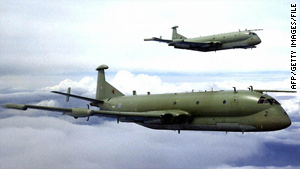Budget focus cited in '06 British air crash

- 14 British service members were killed in airplane crash in 2006
- Defence secretary apologized to House of Commons on Wednesday
- Independent review blamed focus on saving money over safety
London, England (CNN) -- An inquiry into the crash of a British aircraft in Afghanistan three years ago calls the accident "preventable," citing a loss of focus on safety in an effort to save money for the armed forces, the defense secretary said Wednesday.
Defence Secretary Bob Ainsworth apologized to members of the House of Commons for the crash of a Nimrod XV230 west of Kandahar on September 2, 2006. It caused the deaths of 14 people: 12 Royal Air Force members, a soldier and a Royal Marine.
"I am sorry for the mistakes that have been made and that lives have been lost as a result of our failure," Ainsworth said, praising a "rigorous and powerful" independent review by aviation specialist Charles Haddon-Cave of the findings into the incident by a military Board of Inquiry in December 2007.
The Haddon-Cave report, which Ainsworth calls "distressing reading," said that "in our pursuit of financial savings the [Ministry of Defence] and the RAF allowed their focus on safety to suffer," the defense secretary said.
"Safety of our personnel is of paramount importance. That is why this report is so significant," Ainsworth said.
The Nimrod MR2 is "a maritime patrol aircraft used primarily in the roles of maritime surface surveillance, anti-submarine warfare, and search and rescue," according to globalsecurity.org.
The military inquiry in December 2007 said the "most likely scenario" that led to the loss of the aircraft was that "fire most likely resulted from escaped fuel igniting against a hot pipe in a compartment near the wing-fuselage attachment -- the No. 7 tank dry bay."
Ainsworth said Haddon-Cave was "critical of both the MOD and our industrial partners, at both organizational and individual levels" and his report pinpoints "numerous weaknesses in the airworthiness system which we will address thoroughly and urgently."
At the same time, he said, Haddon-Cave said the "report does not raise concerns over the actual airworthiness of individual fleets" and he's been assured by military officials "that our fleets remain safe to fly."
The defense secretary said the government has initiated "comprehensive program" to ensure the "safety and airworthiness of the Nimrod aircraft.
"This involves implementing the recommendations of the Board of Inquiry, including:
• "Ceasing the use of the air-to-air refueling system, as well as the aircraft's relevant hot air systems while the aircraft is in flight."
• "An enhanced aircraft maintenance and systems inspection regime."
• Prohibiting Nimrod aircraft "to fly without having had their engine bay hot air ducts replaced."
• An audit "guaranteeing the safety of Nimrod's systems for its remaining service life."
Ainsworth said the military has established the position of chief airworthiness engineer, a senior position that oversees the "technical airworthiness process, from end-to-end, that is from industry through project teams to the front line ... in accordance with the Department's regulations."
Ainsworth said two Royal Air Force officers "strongly criticized" in the review "have been moved to staff posts which have no responsibility for safety and airworthiness," and the RAF is mulling "what further action should be taken in relation to these officers in the light of the evidence uncovered by the report."
Ainsworth added that the Ministry of Defence will now examine all aspects of the report and produce a full response, updating the House before the Christmas recess.
